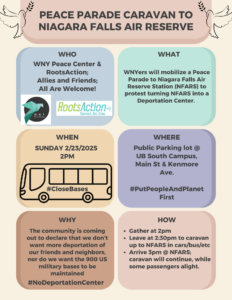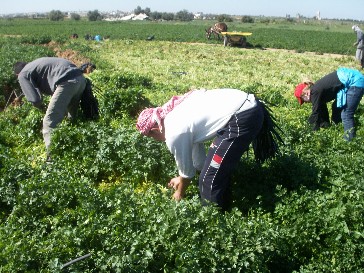Peace Parade Caravan to Niagara Falls Air Reserve


The cost of Israel’s war on Gaza is tremendous and multidimensional. Officially, 41,700 innocent people have been killed — around half of them children. Approximately 1.9 million people, or 90% of Gaza’s population, have been displaced. In the first six months of war, over 70,000 tons of bombs were dropped creating over 40 million tons of rubble. It is estimated that there are over 10,000 bodies that remain unaccounted for, trapped under the rubble. As we mark the one year anniversary of Israel’s relentless and ongoing bombardment of Gaza, let us more closely examine the cost to Gaza’s agricultural infrastructure and the implications of its destruction.
Prior to October 7th, 2023, Gaza sustained a thriving agricultural infrastructure despite the land, air, and sea blockade imposed by Israel in 2007. In 2022, Gaza exported close to $45M in produce sales almost entirely to the West Bank (79% of exports) and Israel (19% of exports). Gaza’s main produce exports are strawberries, tomatoes, and cucumbers but many other crops are grown across Gaza such as olives. The deep connection that Palestinians share with the olive tree for its symbolic representation of resilience in the face of Israeli occupation alongside its many practical uses provide a key role for olives in the local economy. Over the past year, about 60% of Gaza’s farmland has been destroyed or damaged. Experts warn that Israel’s military hardware and extensive bombing will leave the soil infertile. This means that even after the bombs stop dropping, the people of Gaza will remain unable to feed themselves for many years.
Less than 4% of fresh water in Gaza is drinkable and proper hygiene and sanitation are nearly impossible. The United Nations and UNICEF estimate that the average person in Gaza has access to between 1 and 3 liters of water for day for all needs — this is between 5 and 10 times less than the amount of water needed to survive in emergency situations according to humanitarian standards. The shortage of food and water has contributed to the death of around 70% of livestock in Gaza, making it even more challenging for people to nourish themselves.

In 2021, Gaza produced approximately 4,700 tons of fish which is particularly impressive given that fishermen are only permitted to work within 12 nautical miles. Now, almost all of the boats in Gaza’s main fishing port have been destroyed and the pier is no longer functional. Fishermen who attempt to fish for food in the ocean risk being targeted and killed by Israeli forces who routinely open fire on people trying to find food on land as well as at sea. Not only has Israel restricted the access of humanitarian aid into Gaza, but they have also ensured that Gaza is unable to feed itself.
As of October 7th, 2024, Israel believes that there are still 97 of the total 251 hostages being held by Hamas, 64 of whom are believed to still be alive. Until there is a permanent ceasefire and tangible steps are taken toward peace, Israelis and Palestinians alike will continue to be unsafe. The active role of the United States in providing arms to Israel is not helping to stabilize the region — it is only contributing to violence.
Every Fourth Tuesday of the month @ The WNY Peace Center 1272 Delaware Ave. The Carriage House. All are welcomed!